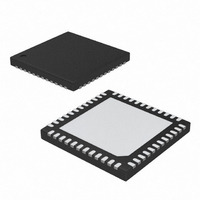MAX8662ETM+ Maxim Integrated Products, MAX8662ETM+ Datasheet - Page 26

MAX8662ETM+
Manufacturer Part Number
MAX8662ETM+
Description
IC POWER MANAGE 48-TQFN-EP
Manufacturer
Maxim Integrated Products
Datasheet
1.MAX8662ETM.pdf
(34 pages)
Specifications of MAX8662ETM+
Applications
Handheld/Mobile Devices
Current - Supply
900µA
Voltage - Supply
4.1 V ~ 8 V
Operating Temperature
-40°C ~ 85°C
Mounting Type
Surface Mount
Package / Case
48-TQFN Exposed Pad
Lead Free Status / RoHS Status
Lead free / RoHS Compliant
Power-Management ICs for
Single-Cell, Li+ Battery-Operated Devices
Connect CT to GND to disable the prequalification and
fast-charge timers, allowing the battery to charge indef-
initely in top-off mode, or if other system timers are to
be used to control charging.
Driving CEN high disables the battery charger. Driving
CEN low enables the charger when a valid source is
connected at DC. CEN does not affect the input limit
current, except that driving CEN high and PEN2 low
activates USB suspend mode.
In many systems, there is no need for the system con-
troller (typically a microprocessor) to disable the charg-
er because the SPS circuitry independently manages
charging and adapter/battery power hand-off. In these
situations, CEN can be connected to ground.
CHG is an open-drain output that indicates charger sta-
tus. CHG is low when the battery charger is in prequali-
fication or fast-charge mode. It is high impedance
when the charger is done, in top-off, or disabled.
The charger faults if the charging timer expires in pre-
qualification or fast charge. In this state, CHG pulses at
1Hz to indicate that a fault occurred.
Battery or ambient temperature can be monitored with
a negative temperature coefficient (NTC) thermistor.
Charging is allowed when the thermistor temperature is
within the allowable range.
The charger enters a temperature suspend state when
the thermistor resistance falls below 3.97kΩ (too hot) or
rises above 28.7kΩ (too cold). This corresponds to a 0
to +50°C range when using a 10kΩ NTC thermistor with
Table 2. Fault Temperatures for Different Thermistors
26
Resistance at +25°C (kΩ)
Resistance at +50°C (kΩ)
Resistance at 0°C (kΩ)
Nominal Hot Trip Temperature (°C)
Nominal Cold Trip Temperature (°C)
______________________________________________________________________________________
Battery Charger Thermistor Input (THM)
THERMISTOR ß (K)
Charge Status Output (CHG)
Charge-Enable Input (CEN)
3000 (K)
25.14
4.59
10
55
-3
a beta of 3500. The relation of thermistor resistance to
temperature is defined by the following equation:
where:
R
perature T in Celsius
R25
ß = The material constant of the thermistor, which typi-
cally ranges from 3000K to 5000K
T = The temperature of the thermistor in °C
Table 2 shows temperature limits for different thermistor
material constants.
Some designs may prefer other trip temperatures. This
can usually be accommodated by connecting a resistor
in series and/or in parallel with the thermistor and/or
using a thermistor with different ß. For example, a
+45°C hot threshold and 0°C cold threshold can be
realized by using a thermistor with a ß of 4250 and con-
necting 120kΩ in parallel. Since the thermistor resis-
tance near 0°C is much higher than it is near +50°C, a
large parallel resistance lowers the cold threshold,
while only slightly lowering the hot threshold.
Conversely, a small series resistance raises the cold
threshold, while only slightly raising the hot threshold.
The charger timer pauses when the thermistor resis-
tance goes out of range: charging stops and the timer
counters hold their state. When the temperature comes
back into range, charging resumes and the counters
continue from where they left off. Connecting THM to
GND disables the thermistor function.
T =
3250 (K)
=
The resistance in ohms of the thermistor at tem-
27.15
4.30
The resistance in ohms of the thermistor at +25°C
10
53
-1
R
T
=
3500 (K)
R
29.32
25
4.03
10
50
0
×
e
⎧
⎪
⎨
⎩ ⎪
β
⎛
⎝ ⎜
T
+
1
273
3750 (K)
31.66
3.78
10
49
2
−
298
1
⎞
⎠ ⎟
⎫
⎪
⎬
⎭ ⎪
4250 (K)
36.91
3316
4.5
10
46











